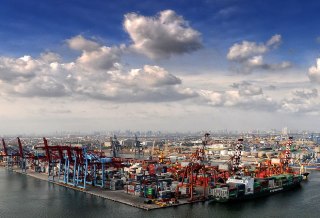 Once operational, the new Kalibaru Port near Jakarta, close to Tanjung Priok port, Indonesia’s main sea gateway, may hold the key to opening up the Asian archipelago to global ultra-large container vessels (ULCVs), according to Drewry Maritime Research.
Once operational, the new Kalibaru Port near Jakarta, close to Tanjung Priok port, Indonesia’s main sea gateway, may hold the key to opening up the Asian archipelago to global ultra-large container vessels (ULCVs), according to Drewry Maritime Research.
Kalibaru Port, also sometimes called New Priok, is due to open the first of three new container terminals in the middle of next year. The first terminal is a joint venture between Pelindo II, the state-owned operator of both Kalibaru and Tanjung Priok, and Japanese conglomerate Mitsui Co., which will develop, build, and operate the Kalibaru box dock.
The three terminals are seen by the shipping community as a first step toward adding more port capacity and encouraging international carriers to offer direct mainline services to the country, a turn of events that could transform the nation’s economy.
Although Indonesia is the world’s fourth most populous nation and Southeast Asia’s largest economy, ocean carriers currently offer no direct services to either Europe or the U.S. due to port capacity shortages.
“As a result, shippers pay a premium in time and cost to access long-haul international services via feeders at Asian transshipment hubs such as Port Klang, Tanjung Pelepas, and Singapore,” said Drewry.
“They also complain of rolled cargo, missed connections and unreliable but expensive all-in packages from 3PLs which then offer little recompense when the shipping leg goes awry.”
A 2011 study by APM Terminals found that five out of the six major Indonesian container ports, which combined handle some 90 percent of Indonesian container traffic, were operating above capacity.
APMT also said the country needed at least 6 million to 7 million TEUs of added capacity by 2015 and an additional 15 million TEUs in place by 2020.
Last year, Tanjung Priok, the country’s largest box port as well as the national hub for most of the domestic services, handled about 6.4 million TEUs, up from 6.2 million TEUs in 2012, close to its maxium capacity.
Hutchison Port Holdings (HPH), which operates the Jakarta International Container Terminal, reported that its terminal handled 3.3 million TEUs in 2013, which Drewry estimates is already close to its maximum capacity of around 4 million TEUs.
Indonesia’s major ports also suffer from shallow drafts. Tanjung Priok’s terminals have a general maximum vessel length of 250 meters and a maximum draft of 11.5 meters.
HPH’s maximum listed draft at Terminal 1 is 11 meters to 14 meters, and just 8.6 meters at Terminal II, which is insufficient for ULCVs.
Carriers say the biggest vessel that could berth at Tanjung Priok is only around 5,000 TEUs, suitable for longer-haul intra-Asia services to North Asia or Australia, but not for the major East-West trades to Europe or the U.S.. This necessitates transshipment, which adds time, risk, and cost into supply chains.
Maersk Line has estimated that on good days, transit times to Felixstowe from Jakarta take 23 days after transshipping at Tanjung Pelepas, compared to 18 days from Tanjung Pelepas direct to the UK.
Evergreen Line’s various services from Jakarta to Rotterdam take from 23 to 35 days, while CMA CGM offers feeder services via Port Klang’s Westport Terminal into Hamburg with transits of 25 to 26 days, compared to transits of 20 to 22 days from Port Klang to Hamburg direct.
The Indonesian Logistics Association says that Indonesia’s logistical costs currently consume about 25 and 30 percent of annual GDP, far higher than comparative figures for Singapore and Malaysia.
Pelindo II believes the three new Kalibaru terminals can vastly reduce this drain on the economy. It puts the building cost of the first terminal at just under US$400 million. Annual capacity will be around 1.5 million TEUs, while the two additional terminals will be built by 2018 and add a further 4.5 million TEUs.
Moreover, the new terminals are due to offer more draft than Tanjung Priok, with depth alongside berths of about 16 meters, similar to that available at Singapore. This will give container lines the option to add Jakarta to mainline strings deploying ULCVs, cutting transit times for shippers and reducing the burden of the logistics costs on the economy.
“Removing the premium imposed on Indonesia’s container shippers will take some time, but adding more port capacity and encouraging carriers to offer direct mainline services is the first step,” said Drewry.




